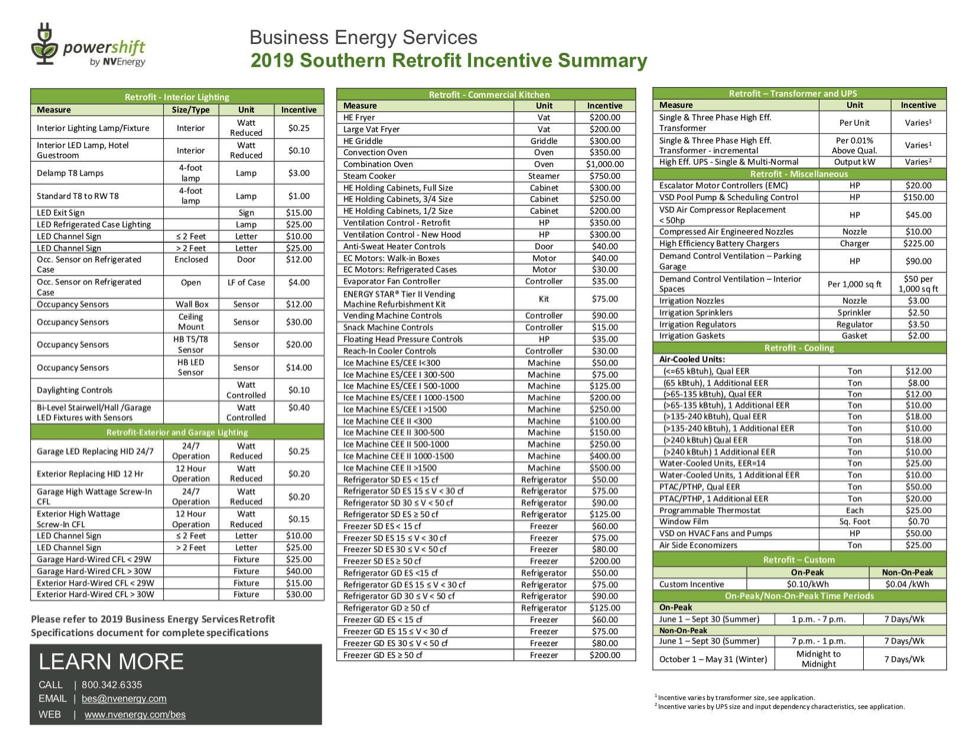Often, when contemplating the ways that the built-environment can help mitigate climate change, the task can become increasingly onerous. For a variety of reasons, it is not always easy to find footing on the path toward sustainability. Nevertheless, they say that the journey of a thousand miles begins with a single step.
One of the simplest ways to curtail the environmental impact of a project is to simply utilize more efficient equipment and lighting, wasting less energy and cultivating valuable financial savings. NV Energy has a program that encourages just that. It is somewhat of a labyrinthine maze of credits and paperwork, but very much worth the effort and planning. The following is intended as an introduction and guide to the process, and, more importantly, to help circulate the information to the architectural community at large.
To start: what exactly is the Powershift program?
Without getting (too) into the weeds, The Public Utilities Commission of Nevada requires that all power-providing utilities (such as NVEnergy) must maintain an energy portfolio consisting of specific quantities of renewable resources and energy-efficiency measures (Energy Credits). NVEnergy can attain this mandated quota by having utility consumers install more efficient equipment and lighting or on-site renewable energy infrastructure, and encourages consumers to do so by offering cash incentives. Essentially, this is a win-win scenario for both sides, allowing NVEnergy to comply with the law, and allowing consumers to save energy and lower their utility bills.
There is one major catch, however. There is only a finite amount of funding that NVEnergy allots for this program, so it is best to apply as early in the calendar year as possible. It can be complicated to plan within a project schedule, but if you wait until too far into the year, the funding will have likely dried up.
The program has two avenues that you can apply to your projects: Existing (Retrofit) and New Construction. Unfortunately, residential projects are not eligible unless they happen to be a part of a mixed-use project. Another caveat is that projects are ineligible for PowerShift program funding if they are already receiving funding via another project (such as the SmartSchools program, another avenue to pursue if your project is an educational facility).
The prescriptive suggestions for upgrades/modifications (outlined below) can be applied to either application route or project type, but it’s important to note that for New Construction, any lighting improvements need to be demonstrably better than IECC standards (10% better than IECC 2009 requirements, or 5% better than IECC 2012 requirements. As of writing this article, I am uncertain if NVEnergy plans to update this to current IECC standards).
Some of the more obvious suggestions for curbing your project’s energy use include (but certainly aren’t limited to) the following:
- Use LEDs for exterior signage; LEDs use 65% less energy than incandescents and emit less heat than neon lights
- Install sensor-controlled bi-level LED fixtures in 24-hour parking garages and stairwells for safety and savings
- Change high-intensity discharge parking lot lights to LEDs or T5 high-output
- Likewise, upgrade any HID fixtures to T5 fluorescent or LED
- Install lighting controls where applicable
- Add controls to vending machines (cut energy use in half)
- Install anti-sweat heater controls on refrigerated cases to reduce heater energy use up to 70%
Other improvements not featured above could fall under the “Custom Measures” category which has its own requirements to consider. For example, the improvement must involve capital investment, savings that are sustainable for 5 years, and also needs to yield measurable energy use reduction. None of these are surprising, but worth mentioning. Energy modeling is another option- if it can demonstrate marked improvements, but it also has its own set of hurdles to clear if you are considering that route. That route is intended specifically for LEED certified buildings, or buildings that are designed to LEED standards. However, the incentives are paid out based on demonstrated annual energy savings calculations.
It’s important to note some of the other measures that are explicitly barred from consideration.
- Fuel-switching (e.g. electric to gas)
- Changes in operational and/or maintenance practices or simple control modifications not involving capital costs
- On-site electricity generation
- Projects involving gas-driven equipment instead of electric equipment (chiller)
- Projects that involve load-shifting (no kWh savings)
- Measures installed with funding from another utility incentive program
Funding for projects is broken into tiers, and can be kind of confusing, at first glance.

The values here reflect the project cost, and are structured to allow for equitable distribution of funds among all applicants. This is intended to prevent a few large projects from obtaining all of the funding. Additionally, customer incentive is limited to 50% of the total project cost to the owner, including the measure equipment and labor, delivery, applicable taxes and installation (i.e., if the project costs $500,000 total, incentives are limited to $250,000; so if a customer spends $100,000 on improvements they could potentially recoup all of the money spent on efficiency upgrades). Labor costs associated with the installation of prescriptive measures can also be factored in to the incentive limits, however, this is limited to 25% of the total project cost.
Following are the spreadsheets found on NVEnergy’s website that detail all of the various modifications you can propose, as well as the associated financial incentive. Hopefully this article helps break down the process a little bit more. We are rapidly approaching 2020, so be sure to check out the applications on NVEnergy’s website. The new year frees up a new pool of funds for your projects!

Adam J. Bradshaw originally studied biology, graduating from the University of California, San Diego with a B.S. general biology in 2008, with the hopes of eventually pursuing graduate studies in ecology and earth systems. He worked in the biotech industry for a time before discovering his interest in architecture. He quickly realized that it was a strangely serendipitous path that allowed him to channel both his creative side and logical side into one. In 2016, Adam obtained his masters degree in architecture from the University of Nevada, Las Vegas, with an emphasis on building science and sustainability, with a thesis titled Water Harvesting Methods and the Built Environment: The Role of Architecture in Providing Water Security. Adam views architecture as a set of tools that, when implemented with careful attention, can be used to solve a number of environmental and anthropological problems intertwined with the built-environment.

